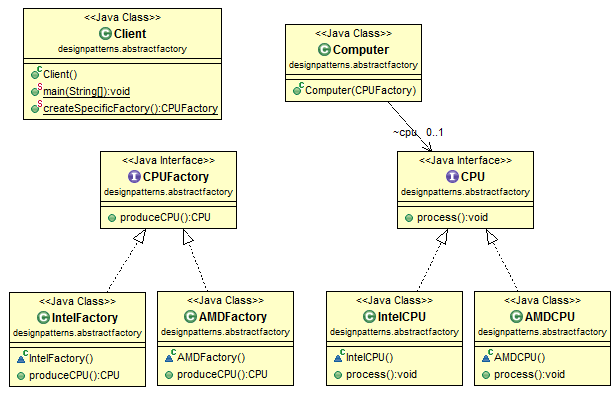Abstract Factory pattern adds another layer of abstraction for Factory pattern. If we compare Abstract Factory with Factory, it is pretty obvious that a new layer of abstraction is added. Abstract Factory is a super-factory which creates other factories. We can call it “Factory of factories”.
Abstract Factory class diagram
Abstract Factory Java code
interface CPU { void process(); } interface CPUFactory { CPU produceCPU(); } class AMDFactory implements CPUFactory { public CPU produceCPU() { return new AMDCPU(); } } class IntelFactory implements CPUFactory { public CPU produceCPU() { return new IntelCPU(); } } class AMDCPU implements CPU { public void process() { System.out.println("AMD is processing..."); } } class IntelCPU implements CPU { public void process() { System.out.println("Intel is processing..."); } } class Computer { CPU cpu; public Computer(CPUFactory factory) { cpu = factory.produceCPU(); cpu.process(); } } public class Client { public static void main(String[] args) { new Computer(createSpecificFactory()); } public static CPUFactory createSpecificFactory() { int sys = 0; // based on specific requirement if (sys == 0) return new AMDFactory(); else return new IntelFactory(); } } |
Real use example
Actually, this is a very important concept of modern frameworks. Here is a question about this.

Java is an excellent programming language but if u want looking for something better u can search here UG Library
This is a good real word example of factory pattern http://www.oracle.com/technetwork/java/dataaccessobject-138824.html
I think Abstract Factory is a very powerful and flexible pattern that can be used in many cases to make a good design of the application domain. I also wrote the article “Design Patterns in real life: Abstract Factory” http://www.davismol.net/2015/03/18/design-patterns-in-real-life-abstract-factory/ where I described a real-case usage of it.